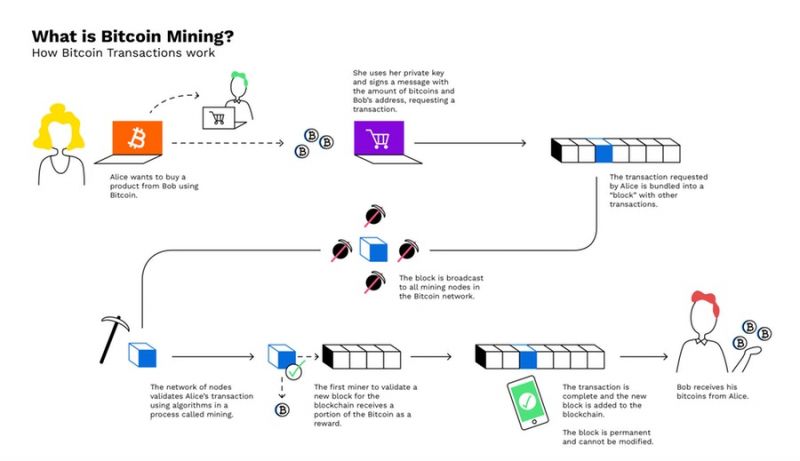Mining: Difference between revisions
Mr. MacKenty (talk | contribs) No edit summary |
Mr. MacKenty (talk | contribs) (→Video) |
||
| Line 19: | Line 19: | ||
== Video == | == Video == | ||
This video is superb and you should watch it several times to understand mining. | |||
<html> | <html> | ||
<iframe width="560" height="315" src="https://www.youtube.com/embed/s7-8a71KgT4" frameborder="0" allow="accelerometer; autoplay; encrypted-media; gyroscope; picture-in-picture" allowfullscreen></iframe> | <iframe width="560" height="315" src="https://www.youtube.com/embed/s7-8a71KgT4" frameborder="0" allow="accelerometer; autoplay; encrypted-media; gyroscope; picture-in-picture" allowfullscreen></iframe> | ||
Latest revision as of 19:59, 8 March 2020

A peer-to-peer computer process, Blockchain mining is used to secure and verify bitcoin transactions. Mining involves Blockchain miners who add bitcoin transaction data to Bitcoin’s global public ledger of past transactions. In the ledgers, blocks are secured by Blockchain miners and are connected to each other forming a chain.[2]
At its core, the term ‘Blockchain mining’ is used to describe the process of adding transaction records to a blockchain. This process of adding blocks to the blockchain is how transactions are processed and how money moves around securely on Bitcoins. This process of Blockchain mining is performed by a community of people around the world called ‘Blockchain miners.’[3]
New blocks are created when a sufficient number of mining nodes have verified a block of transactions. The miners are issued a reward in the cryptocurrency for each block mined, in doing so, more of the specific cryptocurrency is put into circulation.
Explain it Like I'm Five (ELI5)[edit]
"Say I tell three friends that I'm thinking of a number between 1 and 100, and I write that number on a piece of paper and seal it in an envelope. My friends don't have to guess the exact number, they just have to be the first person to guess any number that is less than or equal to the number I am thinking of. And there is no limit to how many guesses they get.
"Let's say I'm thinking of the number 19. If Friend A guesses 21, they lose because 21>19. If Friend B guesses 16 and Friend C guesses 12, then they've both theoretically arrived at viable answers, because 16<19 and 12<19. There is no 'extra credit' for Friend B, even though B's answer was closer to the target answer of 19.
"Now imagine that I pose the 'guess what number I'm thinking of' question, but I'm not asking just three friends, and I'm not thinking of a number between 1 and 100. Rather, I'm asking millions of would-be miners and I'm thinking of a 64-digit hexadecimal number. Now you see that it's going to be extremely hard to guess the right answer."[4]
Video[edit]
This video is superb and you should watch it several times to understand mining.

